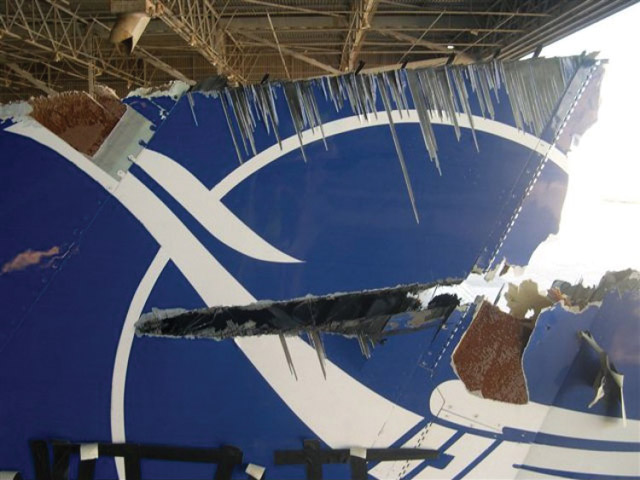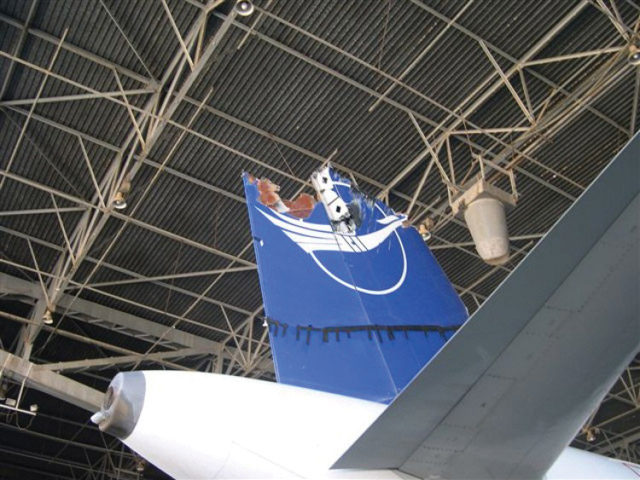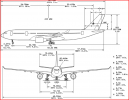It looks like you're using an Ad Blocker.
Please white-list or disable AboveTopSecret.com in your ad-blocking tool.
Thank you.
Some features of ATS will be disabled while you continue to use an ad-blocker.
share:
There's a bit of a mystery in Damascus. A Syrian Arab Airlines flight, with 200 passengers (according to the gov't, Flight says it has 151 seats)
returned to the airport, with substantial damage to the vertical stabilizer beginning at about the 30 foot mark. The top portion of the stabilizer
was ripped off the aircraft, and damage below that point confirms that it was a helicopter rotor that caused the damage.
Reports say that it was most likely either an Mi-8, or Mi-17 that collided with the aircraft, but unverified reports say the collision occurred at 12,000 feet, far above where you normally see a helicopter operating. It appears that the helicopter passed behind the A320, as there is no damage to any structure below the vertical stabilizer.
Source
Reports say that it was most likely either an Mi-8, or Mi-17 that collided with the aircraft, but unverified reports say the collision occurred at 12,000 feet, far above where you normally see a helicopter operating. It appears that the helicopter passed behind the A320, as there is no damage to any structure below the vertical stabilizer.
Mystery still surrounds the circumstances of an apparent mid-air collision involving a Syrian Arab Airlines Airbus A320 that resulted in substantial damage to the twinjet's vertical fin.
The only verification of a collision came from a brief statement released by the ministry of information and carried by Syrian government media, which stated that a military helicopter - possibly a Mil Mi-17 or Mi-8 - had collided with the jet, which had returned to land at Damascus.
Unverified images of a Syrian Arab Airlines A320 in a hangar show damage to the fin and rudder consistent with at least two horizontal clockwise rotor blade strikes at a height of about 9.3m (30ft), ruling out a ground collision because the Mi-17's rotor height is too low.
Source
Looking at a few other news reports, this happened several weeks ago...
link
Given that it makes the Syrian Government look doubly bad (they lost a heli and damaged own plane) then its doubtful they'll wish to ever talk about this ever again.
AFP
September 20, 2012
SYRIA'S state-run TV says that a military helicopter that crashed near Damascus had clipped the tail of a passenger jet with 200 people aboard. The helicopter went down southeast of Douma, a Damascus suburb that has seen clashes in recent days.
link
Given that it makes the Syrian Government look doubly bad (they lost a heli and damaged own plane) then its doubtful they'll wish to ever talk about this ever again.
Yeah, I've followed several aviation sources, daily for the last few weeks (last night of an internet connection other than my phone), and haven't
heard a word about this prior to today. I don't think we're going to hear a word about this after today, and am surprised that the pictures made it
out to be honest.
Thats some pretty major damage .12000 ft ?? at cruising speed ??
Hows the turbulence that close behind a jet
very strange and probably unheard of
www.flightglobal.com...


Hows the turbulence that close behind a jet
very strange and probably unheard of
www.flightglobal.com...


edit on 4-10-2012 by 12voltz because: of extra picture
edit on 4-10-2012 by 12voltz because: (no
reason given)
reply to post by 12voltz
It's pretty bad that close, but I don't think the helo was flying that high. I suspect that it happened at a lower altitude than they're claiming. You don't usually see a helo operating that high.
It's pretty bad that close, but I don't think the helo was flying that high. I suspect that it happened at a lower altitude than they're claiming. You don't usually see a helo operating that high.
reply to post by Zaphod58
looking at that damage ,you've got vertical and horizontal cuts and scraping marks,
If the helo is coming down and from behind which is most likely from the damage ,how can it also cause vertical grazing?
looking at that damage ,you've got vertical and horizontal cuts and scraping marks,
If the helo is coming down and from behind which is most likely from the damage ,how can it also cause vertical grazing?
Can someone help me with understanding how this happens exactly?? The plane was at 12,000 feet. It cruises around 510-540 miles per hour but perhaps
slower at that altitude in what? landing or taking off?...however, still? I mean obviously this DID happen. The proof is right there. How though? I
looked up an MI-8 as one example and it tops out at 160 mph. So....The helicopter was not simply 'flying too close'. The speeds aren't possible.
for them to have been flying together..like the helicopter playing games the way jets do to each other.
So...thinking a bit more...the rotors are..what? 8-10 feet off the ground or height of the landing gear/skids of the helicopter? ....and looking at pictures of A-320's...the level of these blade cuts pose a real interesting mental image, Not just wings...but the horizontal areas of the tail. This got me so curious I looked up a few things.
This is an A340...the best I could find for detail..

and a comparison to the A320 for sense of the difference.

This has to rank as a freak accident to set the standard. The only way I can possibly see this is a near nose-on collision from the Helicopters perspective....after basically aiming or inadvertently being headed directly for where the plane was ABOUT to be...not where it was, in flight. I mean the speed differences for a side approach? What are the odds?? ...and how ELSE could this have happened? Ya got me OP. I'm stumped.
So...thinking a bit more...the rotors are..what? 8-10 feet off the ground or height of the landing gear/skids of the helicopter? ....and looking at pictures of A-320's...the level of these blade cuts pose a real interesting mental image, Not just wings...but the horizontal areas of the tail. This got me so curious I looked up a few things.
This is an A340...the best I could find for detail..

and a comparison to the A320 for sense of the difference.

This has to rank as a freak accident to set the standard. The only way I can possibly see this is a near nose-on collision from the Helicopters perspective....after basically aiming or inadvertently being headed directly for where the plane was ABOUT to be...not where it was, in flight. I mean the speed differences for a side approach? What are the odds?? ...and how ELSE could this have happened? Ya got me OP. I'm stumped.
Does that really resemble a helicopter strike?
keeping in mind the FSA said they would target civy airlines.
I dunno im clueless about this stuff...
keeping in mind the FSA said they would target civy airlines.
I dunno im clueless about this stuff...
reply to post by 12voltz
The vertical damage is most likely from the vertical fin separating. It didn't separate cleanly, and it peeled some of the metal below the cut.
The vertical damage is most likely from the vertical fin separating. It didn't separate cleanly, and it peeled some of the metal below the cut.
reply to post by Wrabbit2000
That's why I say that it probably didn't happen at 12,000 feet. It had to be that they were climbing out, which would be slower than their cruising speed, probably closer to 200-250 mph or so, maybe around 300ish but below cruising speed . It could be that the helo was transiting the area, and wasn't paying attention, and got too close. But I don't see any way that this happened at that altitude.
But wherever it happened, they were incredibly lucky.
That's why I say that it probably didn't happen at 12,000 feet. It had to be that they were climbing out, which would be slower than their cruising speed, probably closer to 200-250 mph or so, maybe around 300ish but below cruising speed . It could be that the helo was transiting the area, and wasn't paying attention, and got too close. But I don't see any way that this happened at that altitude.
But wherever it happened, they were incredibly lucky.
edit on 10/4/2012 by Zaphod58 because: (no reason given)
reply to post by Agit8dChop
That horizontal cut, below where the vertical fin separated, is indicative of something moving at pretty high speed, on a horizontal plane, consistent with a helicopter rotor. I don't know of anything weapon wise that could cause damage like this.
That horizontal cut, below where the vertical fin separated, is indicative of something moving at pretty high speed, on a horizontal plane, consistent with a helicopter rotor. I don't know of anything weapon wise that could cause damage like this.
Either could have flown into the other aircraft from the side, or the A320 climbed into the copter or the copter was descending and het a/c flying
horizontally or climbing.
closing speed depends upon the relative courses and speeds - if they hit head on the might have had a closing speed of 600mph or more - at that speed an aircraft can go from a small dot to filling your windscreen in seconds.
But there are also massive blind spots in which you simply do not see the other aircraft, and it is relatively easy to be in a position where neither aircraft can see the other at all as they close!
See this document for some discussion of the limitations of "see and avoid" - it's a relatively small pdf, and there are many other documents on hte principle.
And then there's the state of air traffic control in the current civil war, and and how the military are paying any attention to it.
closing speed depends upon the relative courses and speeds - if they hit head on the might have had a closing speed of 600mph or more - at that speed an aircraft can go from a small dot to filling your windscreen in seconds.
But there are also massive blind spots in which you simply do not see the other aircraft, and it is relatively easy to be in a position where neither aircraft can see the other at all as they close!
See this document for some discussion of the limitations of "see and avoid" - it's a relatively small pdf, and there are many other documents on hte principle.
And then there's the state of air traffic control in the current civil war, and and how the military are paying any attention to it.
reply to post by Zaphod58
Drones. Drones, drones everywhere...
unverified reports say the collision occurred at 12,000 feet, far above where you normally see a helicopter operating.
Drones. Drones, drones everywhere...
Originally posted by Zaphod58
Reports say that it was most likely either an Mi-8, or Mi-17 that collided with the aircraft, but unverified reports say the collision occurred at 12,000 feet, far above where you normally see a helicopter operating. It appears that the helicopter passed behind the A320, as there is no damage to any structure below the vertical stabilizer.
Well, there are reports of several downed helicopters from Syria already. So if he's up above FL 100, he's probably looking to avoid small arms. Might be command and control, or an EW/ELINT application. Or he's just waiting safely above the the ground fire until he has a target worth expending ordinance on.
Helicopter crew looking down at the ground. Who knows what the airbus crew was looking at. Even a Mi-8 isn't that big in the scheme of things. Add the possibility of clouds. Fortunately, the Airbus made it back. That's a few miliseconds away from a much bigger disaster.
Earlier helo downed by rebels:
www.youtube.com...
reply to post by Panic2k11
This was not a drone. A helicopter went down at the same time this happened. And the drone would have had to be in a vertical position for the type of damage to the A320. And no drone has a propeller big enough to do this.
This was not a drone. A helicopter went down at the same time this happened. And the drone would have had to be in a vertical position for the type of damage to the A320. And no drone has a propeller big enough to do this.
reply to post by Zaphod58
Well if a helicopter was down then it was not a mystery. I was commenting on the strangeness of a collision at such an high altitude. In any case the only reason an helicopter needs to be as high is to avoid ground attacks and control a greater area of terrain (high ground and all that...).
In any case I do not accept the seemingly authority that you place on you statement, that no drone has a propeller big enough or that it needed to be in a vertical position for the type of damage to the A320.
Well if a helicopter was down then it was not a mystery. I was commenting on the strangeness of a collision at such an high altitude. In any case the only reason an helicopter needs to be as high is to avoid ground attacks and control a greater area of terrain (high ground and all that...).
In any case I do not accept the seemingly authority that you place on you statement, that no drone has a propeller big enough or that it needed to be in a vertical position for the type of damage to the A320.
reply to post by Panic2k11
Then come up with an explanation as to how a vertically mounted propeller leaves a horizontal cut, without doing a single bit of damage to any structure but the tail. The only known operational helicopter UAV is the Firescout and it is still in testing and only in very small numbers.
The mystery is what the hell was a helicopter doing at 12,000 feet in a busy corridor where this could happen, not what happened.
Then come up with an explanation as to how a vertically mounted propeller leaves a horizontal cut, without doing a single bit of damage to any structure but the tail. The only known operational helicopter UAV is the Firescout and it is still in testing and only in very small numbers.
The mystery is what the hell was a helicopter doing at 12,000 feet in a busy corridor where this could happen, not what happened.
I think the drone is impossible. Even the damage from the helicopter is tricky to explain with that point of contact. I'm wondering if the helicopter might have been in a rapid descent? That would explain the multiple rotor strikes at different levels and why no other contact was made.
Originally posted by Zaphod58
Then come up with an explanation as to how a vertically mounted propeller leaves a horizontal cut, without doing a single bit of damage to any structure but the tail. The only known operational helicopter UAV is the Firescout and it is still in testing and only in very small numbers.
The mystery is what the hell was a helicopter doing at 12,000 feet in a busy corridor where this could happen, not what happened.
And I'd want to be flying above small arm fire range too, even if it's higher than normal for a helicopter when it's not being shot at.
new topics
-
University of Texas Instantly Shuts Down Anti Israel Protests
Education and Media: 45 minutes ago -
Any one suspicious of fever promotions events, major investor Goldman Sachs card only.
The Gray Area: 2 hours ago -
God's Righteousness is Greater than Our Wrath
Religion, Faith, And Theology: 7 hours ago -
Electrical tricks for saving money
Education and Media: 10 hours ago -
VP's Secret Service agent brawls with other agents at Andrews
Mainstream News: 11 hours ago
top topics
-
VP's Secret Service agent brawls with other agents at Andrews
Mainstream News: 11 hours ago, 10 flags -
Cats Used as Live Bait to Train Ferocious Pitbulls in Illegal NYC Dogfighting
Social Issues and Civil Unrest: 15 hours ago, 8 flags -
Nearly 70% Of Americans Want Talks To End War In Ukraine
Political Issues: 12 hours ago, 4 flags -
Electrical tricks for saving money
Education and Media: 10 hours ago, 4 flags -
Sunak spinning the sickness figures
Other Current Events: 12 hours ago, 3 flags -
Late Night with the Devil - a really good unusual modern horror film.
Movies: 14 hours ago, 2 flags -
Any one suspicious of fever promotions events, major investor Goldman Sachs card only.
The Gray Area: 2 hours ago, 2 flags -
The Good News According to Jesus - Episode 1
Religion, Faith, And Theology: 17 hours ago, 1 flags -
God's Righteousness is Greater than Our Wrath
Religion, Faith, And Theology: 7 hours ago, 0 flags -
University of Texas Instantly Shuts Down Anti Israel Protests
Education and Media: 45 minutes ago, 0 flags
active topics
-
Sunak spinning the sickness figures
Other Current Events • 10 • : crayzeed -
Reason of the Existence
The Gray Area • 20 • : belkide -
Black mirror, what happened.
Television • 20 • : seekshelter -
Any one suspicious of fever promotions events, major investor Goldman Sachs card only.
The Gray Area • 5 • : BeyondKnowledge3 -
Nearly 70% Of Americans Want Talks To End War In Ukraine
Political Issues • 29 • : andy06shake -
God's Righteousness is Greater than Our Wrath
Religion, Faith, And Theology • 25 • : andy06shake -
Russia Ukraine Update Thread - part 3
World War Three • 5730 • : Arbitrageur -
VP's Secret Service agent brawls with other agents at Andrews
Mainstream News • 43 • : Hakaiju -
Everest-sized ‘Devil comet’ Pons-Brooks Visible Now
Space Exploration • 17 • : Compendium -
Nakedeye Mother of Dragons Comet Is Here!
Space Exploration • 5 • : Compendium
